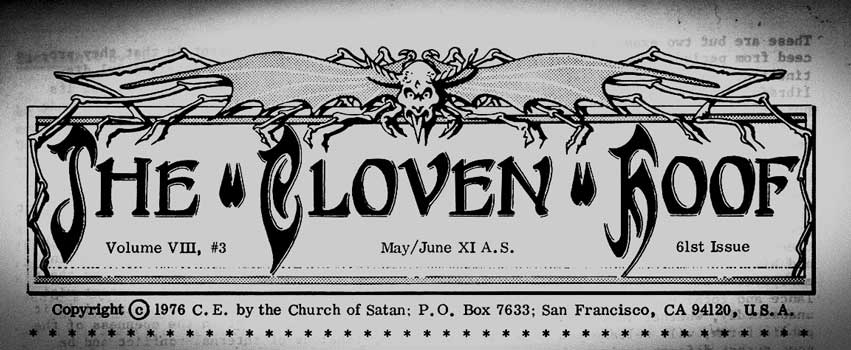

Backlash
by Magus Anton Szandor LaVey
Originally published in The Cloven Hoof, May/June XI A.S. and numbered as the 61st issue.
Copyright by the Church of Satan, 1979, 2023.
It was inevitable. It had to happen. And I couldn’t be more pleased. There used to be a song, “Who Takes Care of the Caretaker’s Daughter?,” that might be answered by a new committee led by Dr. Paul Kurtz, professor of philosophy and editor of The Humanist, and Dr. Marcello Truzzi, eminent sociologist and editor of numerous textbooks on popular culture. The agency’s title pretty much explains its purpose: Committee for the Scientific Investigation of Claims of the Paranormal (Note: Dr. LaVey originally gets this wrong, calling it the Committee to Scientifically Investigate Claims of Paranormal and Other Phenomena, we correct this here and below).
Throughout my career as an observer of human foibles, I’ve witnessed almost every conceivable ploy. In the preface to The Satanic Bible, I wrote, “Herein you will find truth–and fantasy. Each is necessary for the other to exist; but each must be recognized for what it is.” It has become obvious to me, as I stroll through today’s occult fleamarket, that few realize or even entertain a spark of validity in my dictum. What’s worse, the most flagrant B.S. has been authorized by “scientific proof—the “proof” having been attested by way of specious evidence arrived at by “experts” who are often more screwed up than their disciples.
In the Church of Satan, I have tried to work both sides of the street. I realize man’s need to believe and consider the various forms it will take. If I pooh-pooh all elements of the unknown, fantasy, myth-needs, religiosity, and abstraction, I will be a no-good son-of-a-bitch to some fine people, and close-minded as well. If I endorse and propagate the claims and antics of the occult fleamarket I will appear as a silly goof to those who know (or suspect) better of me. I simply perceive the way things really are, like it or not, and respond accordingly.
Pseudoscience has indeed become a religion to be reckoned with. Science itself is a religion to many, science-fiction to others, and pure fiction to a great majority. Pseudoscience, however, has sneaked up on us right on the heels of occultism, from whence it was born. Since most accept some form of occult phenomena (yes, Christianity is a variant of occultism), it is understandable that modern belief in science should be employed to substantiate shamanism. Most of today’s pseudoscientific shamans are not concerned with exploration of undiscovered or unexplained matters. They are concerned with furthering their personal interests and with recognition, much as any tribal priest or mitt camp seer. There is some difference, though. Most medicine men, mitt camp workers, and Jesuit priests at least secretly know the score. The contemporary phenomenon phakir basks in a new sun of radiant credibility that is so warm that it bakes out any self-awareness of his motives and often even his methods.
It used to be that many unsavory acts were perpetrated “in the name of God.” Periodically, similar acts were done “in the name of Satan,” though never on such a wholesale scale. Now that occultists, astrologers, psychics, and their kind have been blessed with a shred of scientific interest (translate = validity) they have taken the ball and run with it. Old-time fortune tellers learned their trade through trial and error or had it passed on to them, yet were stigmatized. Preachers who dispensed similar advice from On High were immune from examination or scientific evaluation because their lot was “Religion.” By today’s standards a swami is a Very Special Person, worthy of scientific evaluation. A fortune teller should have the same rights as a minister. They are much the same. It is, however, the seer’s entry into the province of science that has altered his level of popular acceptance. And it is that very tool—science—that has become the gaff, clincher, and shtick of irresponsible miracle workers and their fellow travelers.
What kind of “investigators” have we seen in the past decade? From my experience, the investigators should be investigated more and phenomena less. Are people like Puthoff, Targ, Von Däniken, Puharich, Holzer, Hynek, Berlitz any more or less credible than bible-thumping Ed and Lorraine Warren or bountiful Bevy Jaegers’ “psychic rescue squad”? I think not. Is the pulp playground of Fate magazine any more valid in content than the saccharine slick pseudoscience of Psychic magazine? Hell, no. It’s time to take a good, hard look at the peddlers in the occult fleamarket who are doing their best to evaluate others. Kurtz and Truzzi’s team contains enough “backlash” personalities to at least balance the scales.
Whenever I have delved into a bizarre or abnormal situation, my initial interest has been in the person who called it to my attention. In other words, what’s in it for them. Using this approach, a lot surfaces—whether the issue is poltergeists or “cattle mutilation,” UFO’s or “bigfoot” (“bigfeet”?). I’ve found that an alarmingly disproportionate percentage of informants and experts have their own problems, and I don’t mean like noisy transmissions or leaky faucets. Seldom do the problems concern the IRS or an unruly employee, either. I mean problems such as lack of romantic or sexual gratification, religious stigma, physical infirmities, sour grapes, past or present rejection, authority resentment, lack of attention, inability to make or keep friends, boredom, overly-disciplined or dependent lives, watching too many reruns of Star Trek or Dark Shadows, taking Son of Satan and Vampirella comics too seriously—put all or part of them together and out comes the genuine article, at least if a dash of credibility can be added. I’ve seen academic worthies with strings of letters lead open-minded and otherwise intelligent colleagues down the bunkum path, because those worthies had a psychical skeleton or two in their own closets.
Plain, old-fashioned naivete is responsible for many clouded or obscured explanations of supposedly supernormal phenomena. Thanks to competent stage magicians, explanations of many things are available—to those who really want explanations. It was just such a magician, Joseph Dunninger, who regularly closed his show with, “For those who believe, no explanation is necessary; for those who do not believe, no explanation is possible.”
Is science to blame for the rapid growth of pseudoscience? It would be unfair to condemn the scientific community for the damage perpetrated by its bad apples. When one considers what constitutes irresponsibility on the part of science, visions of mad doctors and frustrated vivisectionists appear. Or Doctor Strangeloves and other explosive types. Few consider the most dangerous of all bearers of scientific credentials: he who would employ science to reinforce existing religiosity or develop an even more illogical set of myths. To quote Paul Kurtz, “Perhaps we ought not to assume that the scientific enlightenment will continue indefinitely; for all we know, like the Hellenic civilization, it may be overwhelmed by irrationalism, subjectivism, and obscurantism. Perhaps antiscientific and pseudoscientific irrationalism is only a passing fashion; yet one of the best ways to deal with it is for the scientific and educational community to respond—in a responsible manner—to its alarming growth.” When the scientist becomes the mythmaker, progress cannot help but be aborted. What kind of scientist becomes a mythmaker? The same kind of humanitarian that becomes a zealot and kills because of his great love for mankind. And we all know what kind of an outfit produced a goodly supply of that type.
How does this concern Satanists? If Satanism opposes that which “goes without saying,” the enshrined lie, whatever has become hallowed by half-truths, Satanism’s purpose is in part fulfilled. The cardinal sin of Satanism is stupidity. When mass acceptance of anything occurs it is not because of any discrimination—only stupidity. If it is to an exploitive Satanist’s benefit that many should remain ignorant, there is no need to worry about a shortage of fools, however. Despite science and Herbert Spencer, there will always be nitwits among us, and many out of choice. W. Somerset Maugham observed, “Most people are such fools that it really is no great compliment to say that a man is above the average.” When it comes to foolishness, I like to think that at least Satanists have a choice. Or if they have no choice, at least are a bit less heavy-footed than others.
The distance between supernormal and superstition is becoming increasingly smaller, and in many fields has already overlapped. Two recent examples are noteworthy. Both are natural phenomena, treated as supernormal, and becoming superstition. The first is the “possession” syndrome, which has been discussed in these pages before. There is no case of “possession” on record which cannot be explained, by rational means, as a psychoneurotic reaction to any number of influential factors. The second example is the wave of “cattle mutilations” which have filled dead media space for the past few years. Despite exhaustive proof of being a hoax, including confessions, official autopsy reports, statements of dismissal from every investigative agency, and personal observation of natural predators from vantage points, the myth still crops up and articles are, at this moment, being prepared for circulation. Why? Because it’s fun to believe and “truth” is stranger than fiction. And all you need is one or two “accredited” sources to turn the biggest whopper into a popular myth that is accepted without question.
The new Committee for the Scientific Investigation of Claims of the Paranormal has already observed the effect of sour grapes, which is ample testimony to its potential efficacy. I know. With all the good wine in the world, it always fails to amaze me how many people raise sour grapes.
Good luck, CSICOP and Zetetic1. Your work’s cut out for you.
1. The Zetetic was the name of the official magazine of the Committee for the Scientific Investigation of Claims of the Paranormal under the editorship of Marcello Truzzi until 1977, at which time he left the organization after receiving a vote of no-confidence from the Executive Council. The magazine was then renamed Skeptical Inquirer and was edited by the late Kendrick Frazier until his death on November 7, 2022.

Portrait

Anton Szandor LaVey
Founder of the Church of Satan
We Are Legion
A Moment In Time
This slideshow requires JavaScript.
SUPPORT THE
CHURCH OF SATAN!
There are many ways you can support the Church of Satan. Visit our support page to learn how.
navigation-topper


